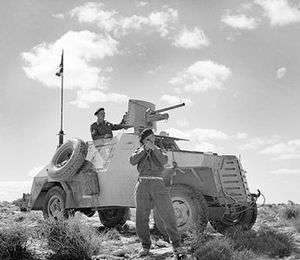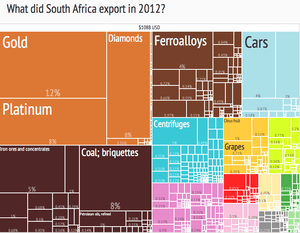Automotive industry in South Africa

South Africa is traditionally the leader in Africa of the automotive industry and now produces more than half a million annually of all types of automobiles. While domestic development of trucks and military vehicles exists, cars built under license of foreign brands are the mainstay.
Current Situation

The modern automotive industry in South Africa was launched in 1995 and has since provided a large amount of exports. It has motivated global motor vehicle manufacturers to grant production contracts to South African factories.[1] South Africa has been engaged in the assembly of motor vehicles and light truck models since the 1920s, with the country's main international manufacturers being:
These manufacturers are all concentrated in the Provinces of Eastern Cape, Gauteng and KwaZulu-Natal. With the Motor Industry Development Programme (MIDP) doubling in size between 1994 and 2012.[2] it continues to grow and in recent history it has seen its successor Automotive Production and Development Program (APDP) enforce new aims, hoping to achieve local production of 1.2 million vehicles annually by 2020.[3]
Volkswagen have had a factory in Eastern Cape since the early 1950s, which now employs around 6,000 people and produces 120,000 vehicles per year, of which 40,000 are exported to fellow African countries. The Volkswagen group holds a market share of approximately 22.1% in South Africa.
BMW caters for 5,000 employees in South Africa and manufactures around 55,000 a year, the BMW Rosslyn Plant in Gauteng was founded in 1968 and plays an important role in the production of equipment used in vehicles.[4]
Mercedes-Benz manufacturing plant was founded in South Africa, Eastern Cape around 1954 and produced 55,900 vehicles in 2010 and in the same year the local market saw Mercedes-Benz sell 25,400 cars and 6,100 trucks.[4]
MAN has been present in Africa since 1968 and positions itself well in South Africa, maintaining two plants and a "spares" depot, employing 393 citizens who produce around 2,500 vehicles annually find that they sell almost entirely on the Southern Africa markets.[4]
Nissan also have a plant in Rosslyn, manufacturing mostly bakkies.[5][6]
History
Early days
The early days of the South African motoring industry were focused on British makers and, to a lesser degree, American makers. Volkswagen was also a long-term presence, being particularly popular with those Afrikaners who were unwilling to buy a British car.[7] By the late 1970s, Japanese producers had gained a foothold and British makers were being pushed out. In the late seventies, Sigma Motors had planned to merge with British Leyland, known as Leykor locally - when this merger failed, Leyland had to scramble to create an all-new dealer network in only a month.[8] Leyland's South African presence never recovered.
After the fuel crisis, the large American cars which had been very popular dropped in sales drastically. By the end of the 1970s, the Mazda 323 and the Volkswagen Golf were the biggest sellers and American-designed cars were no longer regularly available. For a while, the demand for big saloons had been met by assembling the somewhat more compact Australian Fords and Holdens, but these were discontinued in favour of more compact European designs.[9] Following the beginning of UN sanctions against apartheid, the economy tightened and 1976 showed the worst sales numbers since 1972.[10] Chrysler SA went belly up soon thereafter, merging with Illings (Mazda) to form Sigma. Chrysler had been very successful in the late sixties, with the Valiant range being the most sold passenger car in 1966, 1967, and 1968, but began a serious slide after that.[11] The introduction of Mitsubishis gave Chrysler a stay of execution but the severe economic climate of the latter half of the 1970s proved too much.
Growth
The automotive industry catered for 303,000 employees in South Africa in 2003 and in 2004 the country exported fully assembled motor vehicles to 53 countries including many developed countries such as Japan, United States, United Kingdom, Australia and Germany, with many of the manufacturers based in South Africa now making it their main production base. In 2004 was responsible for the manufacture of 84% of all vehicles produced in Africa, 7 million of which are on the South African roads. Also in 2004, the industry had a 6.7% contribution to the GDP of South Africa and had 29% of all South African manufacturers under the automotive industry. 2004 also saw 110,000 vehicles exported from South Africa of which 100,000 were passenger vehicles.[1]
In 2007 the automotive industry grew again, producing over 500,000 vehicles annually. While equating only a small factor of the global vehicle production of 73 million,this did make great local contributions, making up 7.5% of the country’s GDP. In 2010 the National Association of Automobile Manufacturers of South Africa (NAAMSA) reported that the new vehicle sales exceeded their initial expectations of 7%,with the large local growth allowing it to reach 24% instead, providing a large boost after the 2008/09 recession. This was reflected in 2010 showing 271,000 vehicles being exported, more than double what was seen in previous years.[12]
Government Programs
Regulations for local content requirements first appeared in the 1960s and were quite strict, and led to a limited number of cars being available to South African motorists. Beginning in the late 1960s, engines had to be built locally for the car to be considered a local product. Phase III of the requirements, for instance, was planned for introduction in the 1970s and required local content to reach 70 per cent of a vehicle's total weight. Manufacturers als received tax rebates for additional local content. Early in the program, models were often sold as "declared manufactured", but the government gradually began enforcing the standards and imposing penalties.[13]
The South African government has provided substantial support for the automotive industry in the past 20 years and is still identifying it as a key growth sector. In a Department of Trade and Industry (dti) Budget Vote Address delivered in July 2014, Trade Minister Rob Davies said that “given that automotive manufacturer and components comprises 30% of our industrial sector, with strong linkages to other manufacturing sub-sectors, the impact of such investment on our domestic economy is significant.”[14]
The Department of Trade and Industry has provided a series of programs in order to assist the sector. The first of the programs—MIDP—was introduced in 1995. The program had the following key objectives:
- Improvement of South Africa’s automotive industry’s international competitiveness Improvement of vehicle affordability in the domestic market
- Encouragement of growth in vehicle and component manufacturing, mainly through exports
- Stabilizing the employment levels in the industry
- Creating a better industry foreign exchange balance.
The program is considered a great success. Under the MIDP, the sector exhibits significant growth – it almost doubled its size since 1994.
Its successor is the APDP, which was implemented on January 1, 2013. The APDP’s main goal is to simultaneously stimulate the expansion of local production up to 1,2- million vehicles a year by 2020 and increase significantly the local content. The intention is to achieve that through investments, unlike the MIDP which relied mainly on exports. According to the National Association of Automotive Component and Allied Manufacturers (NAACAM), the program has four pillars:
- Import Duty
- Vehicle Assembly Allowance (VAA)
- Production Incentive (PI)
- Automotive Investment Scheme (AIS)[15]
The fourth pillar is not a new initiative but a revised incentive. The Automotive Investment Scheme (AIS) was first introduced in 2010/2011 and since then incentives in the public sector have amounted to R6.3 billion and supported investments worth R23 billion by original equipment manufacturers in the automotive sector.
Quality and Productivity
Quality
Quality is a big factor in production, a factor such as quality can be a defining factor in the success of an industry.[16] It is then important for the future development of South Africa’s car industry. Since around 7% of South Africa’s economic output is attributed to the automotive industry it is well known that the government and companies within South Africa have been trying to encourage greater quality and greater productivity.[17]
The government has been using harsher controls as a way to improve quality. This seems to have worked with large improvements in quality being made with the introduction of tighter controls making the industry as a whole more investible to foreign countries.
The quality of car production in South Africa has been greatly increasing with the goal of production equal quality to car manufacturing plants in western Europe which are responsible for some of the world most quality controlled production in the automotive industry.[18] With quality of cars reaching comparable levels to western European production exports are increasing. Production has been down but quality has gone up and has yielded more profit from it.
Productivity
The majority of South African automotive companies have been vocal about their concerns about productivity. While labour productivity in the sector increased by 37% from 1993 to 2001 companies still have concerns about the productivity levels they can achieve in the country. Recent low productivity levels have been attributed on management. Both inadequate management and low trust in management has help to contribute in a lull and decline in productivity.[19] With labour productivity and transportation being said to be the two biggest problems in the industry it has become an important issue to try to be addressed.
South Africa has many ways to start improving productivity through stricter or less strict regulation or through investment in automation. Both could potentially help to increase productivity helping to improve the vital South African automotive industry.[20]
References
- 1 2 "South African Embassy - Automotive Industry". www.zuidafrika.nl. Retrieved 2015-12-10.
- ↑ "South Africa's automotive industry". www.southafrica.info. Retrieved 2015-12-10.
- ↑ "Made In Africa: South African Auto Industry Strong Thanks To Financial Stability". AFKInsider. Retrieved 2015-12-10.
- 1 2 3 "German Missions in South Africa, Lesotho and Swaziland - Automotive sector". www.southafrica.diplo.de. Retrieved 2015-12-10.
- ↑ "TEDA Business Review Volume 7" (PDF). Tshwane Economic Development Agency. Retrieved 14 May 2016.
- ↑ "Nissan to announce production plans for Rosslyn plant by end-2015". Engineering News. Retrieved 14 May 2016.
- ↑ "Experts talks on automotive industry in SA". carkingdirect. Retrieved 27 October 2016.
- ↑ Haler, Justin, ed. (July 1979). "Editor's Log". SA Motor. Randburg, South Africa: SA Motor (Pty) Ltd. 17 (7): 7.
- ↑ Thomas, Harvey (July 1979). "Dramatic shift in car buying". SA Motor. Randburg, South Africa: SA Motor (Pty) Ltd. 17 (7): 30.
- ↑ Howard, Tony, ed. (December 1976). "Editor's Desk". SA Motor. Cape Town, South Africa: Scott Publications: 9.
- ↑ Howard, Tony (October 1976). "Chrysler on the move". SA Motor. Cape Town, South Africa: Scott Publications: 18.
- ↑ "Automotive in South Africa - Key information on the South African motor industry". MBendi.com. Retrieved 2015-12-10.
- ↑ Emslie, Robin (September 1969). "Mirrortalk". Motoring Mirror. Cape Town, South Africa: Motorpress. 7 (5): 33.
- ↑ "Speeches". www.thedti.gov.za. Retrieved 2015-12-10.
- ↑ "The APDP - Summary, Comment & Review". naacamdirectory.webhouse.co.za. Retrieved 2015-12-10.
- ↑ "In The Race For Success, Quality Is More Important Than Productivity". www.manufacturingnews.com. Retrieved 2015-12-10.
- ↑ "What the UK motor industry can learn from South Africa? | Talk Business Magazine". Retrieved 2015-12-10.
- ↑ Cauvin, Henri E. (2001-11-24). "A Quest to Promote the Quality Of Cars Made in South Africa". The New York Times. ISSN 0362-4331. Retrieved 2015-12-10.
- ↑ Meyn, Mareike. "The Export Performance of the South African Automotive Industry. New Stimuli by the EU-South Africa Free Trade Agreement?" (PDF). Institute for World Economics and International Management. Retrieved 2015-12-10.
- ↑ Kaggwa, Martin. "Modelling South Africa's Incentives Under the Motor Industry Development Programme" (PDF). Institutional Repository of the University of Pretoria. Retrieved 2015-12-10.
External links
- http://www.bmw.co.za/en/index.html
- http://www.gov.za/
- http://www.chrysler.co.za/
- https://www.gmsa.co.za/